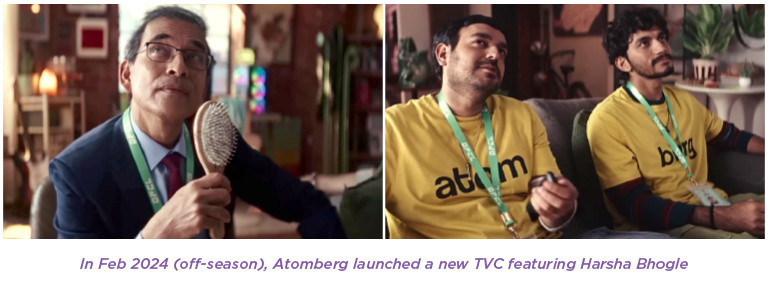Just like American Jazz musician Chet Baker didn’t want to limit Valentine’s Day to February 14, but instead sang about celebrating it every day with his lover, brands, even the seasonal ones, try to seek visibility every day, finding new and old ways to stay constantly connected with consumers. Over the years, seasonal brands have attempted to extend their presence even in the off-season, thanks to Digital, higher disposable incomes, and this abomination called climate change. But the main question remains: is this enough to put a dent in the concept of seasonality?
Seasonal products, such as air conditioners, fans, aerated drinks, inverters, and ice creams are starting to distribute their ad spends throughout the year to achieve perennial visibility. TAM data indicates that while these products still see most traditional medium ads in peak months (between March and June), when it comes to digital, the expenditure is not limited to the prime months.
Bringing more clarity, Anil Suryavamshi, Associate Vice President, Digital Planning, Carat India shares, “The gap between seasonal and year-round marketing approaches in India has indeed reduced over the past three years. Advertisers embrace a holistic and strategic approach to engage with consumers, leveraging digital innovation, data analytics, and integrated campaigns to drive brand growth and market share.”
Similarly, Girish Hingorani, Vice President of Marketing (Cooling and Purification Appliances) and Corporate Communications, Blue Star mentions that the company has started spending more during off-season with the help of Digital and E-commerce. “Now, our ad spends on traditional mediums are skewed towards the summer months, but spending on Digital and E-commerce happens throughout the year. This is why our advertising budget for summer initiatives has plummeted from 90 to 65% in the last few years. And hence, Digital and E-commerce now make up 40% of our total media spends,” he says.

As we all know, Digital is increasingly becoming part of everybody’s media plan, helping brands with affordability. After all, it can create a connection with consumers on social platforms, where they spend a large portion of their time. The sharper targeting in Digital – in terms of in-market audience, geographic targeting, and the ability to place content in context – plays a key role in spend allocations favouring Digital.
Along similar lines, NS Satish, President, Haier Appliances India remarks, “To maintain visibility throughout the year, we have curated a strategy which allocates approximately 60% of our marketing budget to Digital channels and the remaining 40% to traditional media, targeting the younger, tech-savvy demographic. Beyond seasonal considerations, we leverage prominent sporting events like IPL 2024 to extend our reach to millions, ensuring comprehensive visibility through our advertisements and securing substantial mindshare among our target audiences.”
Despite the strong pull in favour of ACs, largely created by weather change, and rising disposable incomes, its penetration remains low. Ostensibly, the category is becoming a necessity rather than a luxury in Tier II and III cities, showcasing a galore of opportunities. On the contrary, metros are experiencing year-round demand, making AC brands communicate throughout the year.

Addressing the same, Gaurav Dudeja, CEO, FCB Interface voices, “India’s AC market has a low 7% penetration but shows great growth potential, particularly in Tier II and III cities where rising incomes are turning ACs from a luxury into a necessity. However, demand remains seasonal. In contrast, super metros experience year-round demand due to longer summers, E-commerce discounts, and higher living standards. While seasonality will persist as a demand driver in the near term, metro trends indicate a shift towards a more stable market, necessitating a continuous marketing strategy.”
Brands aim to continuously reinforce their brand positioning and build strong relationships with consumers. It is said that consistent communication and engagement throughout the year help to capture the seasonal demand and establish them as a trusted brand that customers can rely on beyond the summer months. Furthermore, it is also claimed that the wave of premiumisation is reducing seasonality spikes.
Shedding light on the same, Swati Rathi, Head of Marketing, Godrej Appliances voices, “Given our strong presence in cooling categories like ACs, refrigerators, air coolers and deep freezers, ad spends are higher for us in summers. Having said that, with the wave of premiumisation, the seasonality spikes are lower and there is an underlying volume of demand for cooling products throughout the year, which translates into year-round spends, especially on Digital medium.”

Similarly, Dhiraj Sharma, Head, Marcom & Brand, Panasonic Marketing India, PLSIND says, “Our marketing strategy has evolved over the past three years. While traditionally emphasising summer sales for ACs and refrigerators, we’ve consistently engaged customers year-round through campaigns tied to festivals, cultural events, and popular occasions such as the IPL. The affordability of digital marketing has played a pivotal role in allowing us to spread our spending throughout the year. Thanks to the ubiquity of smartphones and widespread internet access, our digital campaigns have flourished—because in today’s world, even refrigerators need to stay cool online.”
Brands such as Panasonic and Voltas have extensively embraced the multi-channel approach. Multi-channel marketing reportedly makes it possible to boost engagement, promote brand consistency, expand outreach, and streamline the customer journey. But more importantly, the multiple-channel approach paves the way for constant and continuous communication.
Talking about it, Deba Ghoshal, Vice President and Head - Marketing, Voltas Ltd. mentions, “We have employed a multi-channel approach for our marketing initiatives during the peak season, leveraging mediums such as Television, Radio, OOH and Digital platforms. In recent years, Voltas has increasingly embraced digital mediums, as we recognise the growing importance of online channels in reaching and engaging consumers throughout the year.”
On similar grounds, Neelima Burra, Chief Strategy, Transformation and Marketing Officer, Luminous Power Technologies voices, “Luminous consistently employs integrated marketing for its products, with year-round campaigns across Digital, Social Media, Print, and TV. In addition to collaborating with influencers, we have partnered with Rajasthan Royals as their title sponsor to broaden our reach.”
TAM study highlights that fans, like other seasonal products, continue to see most traditional medium ads between March and June. Digital on the other hand sees most ad impressions between August and December.
Putting forward some observations, Pradyumna Poddar, President, Electric Fans, Usha International notes, “Fan sales peak in Q4 and Q1, making up 60% of yearly sales, while Q2 and Q3 contribute the remaining 40%. Advertising budgets, therefore, align with these trends. Product launches are announced in Q3, with distribution beginning in Q4 to ensure wide availability for the high-sales seasons. Over the last five years, Digital became an important advertising channel, and its spends increased to double-digits.”
Ice cream is one category that holds a timeless appeal. Enjoyed by people of all ages year-round, the allocation of their advertising spends is a nuanced balance between maintaining a year-round presence and strategically focusing efforts during peak seasons. On top of it, the gap between ad spends on ice creams and other seasonal products in the off-season and peak season is not the only thing that is said to be reducing. The gap is reducing, even in terms of sales distribution.
Talking more about it, Aleesha Desai, DGM Marketing, Baskin Robbins India says, “Just a couple of years ago, our spends was primarily focused on the summer months. However, with a shift in consumption patterns and evolving consumer behaviour our spending habits have now transformed. Now, our expenses are distributed throughout the year. Summer, which claimed 70% of our sales earlier, now sees less than 60% of sales, mirroring the shift in year-round consumer indulgence.”

It is evident that seasonal brands have reduced this gap as far as sales and marketing initiatives are concerned. Nonetheless, being visible in the peak seasons remains the top priority of seasonal products.
Breaking it down further, Aman Kochhar, Chief Growth Officer and Managing Partner - Motivator (GroupM) elucidates, “Maintaining share of voice in a peak season is one of the primary key result areas that all brands try to vie for. Because there is clear category spending and competitive pressure during a season, staying top of mind within a budget remains the top consideration. Long-term spending has a definite impact on brand health but with no business to support it becomes an untenable option.”
Experts like Aman Kochhar find that the emergence of the festive season as a high point has led to aerated drinks spending more in off-seasons. When these festive seasons coincide with big events like the IPL or the World Cup, the results are nothing less than phenomenal.
Painting a picture of their vision for the summer months, a PepsiCo spokesperson shares, “While there is a growing round-the-year demand for our beverages, we are always excited about welcoming the summer months which naturally is the most favourable season for our category. We are optimistic that our broad portfolio will continue to delight consumers over the summer months.”
The peak season remains important for seasonal brands, but now even the off-seasons matter. Additionally, various factors are trying to dent seasonality, creating a strong case for year-round initiatives. Experts note that the adoption of year-long engagement, leveraging digital platforms, diversifying marketing channels, creating integrated campaigns, measuring performance and personalisation of ads can lead to favourable outcomes.
Speaking on this, Anil Suryavamshi argues, “In a departure from conventional seasonal marketing, products once tethered to specific seasons experience blurred boundaries. Factors like increased disposable incomes and impulse buying contribute to a more evenly distributed pattern of purchases year-round. Brands now recalibrate marketing strategies to align with evolving consumer preferences and market dynamics. The focus shifts from concentrated seasonal spikes to sustained engagement, with marketers leveraging diverse platforms for visibility and engagement.
Similarly, Amyn Ghadiali, Country Head - India (GZ Creative Digital), GOZOOP Group remarks, “In today’s marketing landscape, the savvy CMO balances seasonality and topicality, allocating 60-65% of the budget to ATL channels during peak season while maintaining a continuous presence on digital platforms. Engagement on digital platforms drives brand campaigns, guiding them to elevate sales and brand perception. As the consumer journey becomes non-linear, brands must innovate to capture audience intent. The CMO’s decisions steer the brand’s journey, turning marketing into a strategic investment.”
Trends such as rise in disposable incomes, credit options, digitisation, urbanisation, and climate change, to name a few, propel the demand for seasonal products. On top of it, the curious case of India’s geography, with varying weathers, also appears as a challenger to seasonality.
Sharing his insights, Sourav Ray, Chief Strategy Officer, Cheil India says, “Factors such as growing disposable incomes, easy access to finance schemes, evolving lifestyles, rapid urbanisation and climate change are helping brands to put a dent on the concept of seasonality. Furthermore, the geographical diversity of India ensures an opportunity unlike any other country in the world for categories typically seen as seasonal. With hot to moderate temperatures, and high humidity through the year in the south and west, the relevance of this category continues to be year-round.”
As brands adapt to changing consumer behaviours and market dynamics, the once-rigid boundaries of seasonality are blurring. While peak seasons remain vital, the focus shifts towards sustained visibility and consumer connection.























